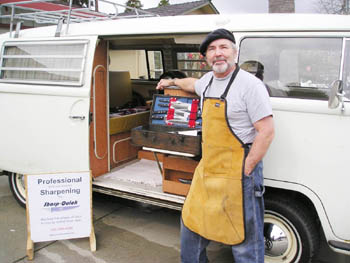![[Metroactive Dining]](/gifs/dining468.gif)
[ Dining Index | Santa Cruz | Metroactive Home | Archives ]
Knife Knife Baby
Terry Beech is a know-it-all when it comes to knife-sharpening etiquette
By Steve Billings
During college, I hid my new German kitchen knives in my bedroom closet so they wouldn't get trashed in the bluster of our hard-living co-ed kitchen. When we had parties, I would steal away upstairs to get my chef's knife, do my prep work, wash it with soapy water, dry it with a towel and put it back in the wood block from whence it came. Safe. Clean. Sharp. Mine.
That was years ago. I've lightened up a bit. Other people use my knives, but still I don't like sharing. And though I have continually honed my blades with the steel provided to keep them sharp, much time has passed, many meals have been made. Adding to this general demise, the tip of my beloved chef's knife was lost when one fateful night my housemate hip-checked the chopping block and the knives that sat atop it to the ground.
And until I met Terry Beech, I thought my emasculated knives would never be the same again.
Terry tells me he's been sharpening knives his whole life but decided to go into business in October 2003. A self-proclaimed dotcom dropout with a master's in physics, Terry looks much more comfortable grinding edges than he ever would in a Silicon Valley office building.
His current mobile office is a 1970 VW bus outfitted with grinding machine, tools, the knives he sells and good acoustic music. He makes house calls to private residences as well as servicing businesses in Santa Cruz and Monterey counties. If you call your foodie friends, tell them to bring their knives, and then invite Terry over, you've got a bizarre twist of Tupperware meets E. Scissorhands. I'll bring the tomatoes.
As he begins work on the first blade he shares the basic philosophy of what he does.
"You've got a nice piece of steel here. Somebody spent a lot of time and energy to put this thing together so let's try and make this thing last as long as possible. People hand them down to their children, put 'em in their wills, and that's a good thing."
Terry makes these things last by keeping them finely tuned and taking only what he needs to make the blade sharp again. To grind edges he uses a circular water-cooled aluminum oxide stone that rotates at a very slow speed. The system allows him to set and maintain a very precise, constant angle, and since he does it all by hand, he has a great deal of control when he draws the knife across the stone from bolster to tip.
As he grinds the edge he removes steel from the blade to reshape the knife to an optimum cutting or chopping angle. The knife is sharpened one side at a time, the goal being to "raise a burr" on each side which you can feel with your finger by gently touching the bottom of the blade.
After the edge has been roughly sharpened, the blade must be honed on the machine's opposing wheel which is impregnated with a very fine grit paste. The paste removes any remaining roughness. For most kitchen applications a polished edge is very desirable because it causes less friction and allows the edge to hold up longer.
"A lot of knife grinders don't hone their knives, they just grind them. And almost no one polishes. I hone and polish every edge." This extra step is indicative of the way Terry approaches his craft.
"I have customers that tell me that my edges last longer than anybody's. One of the butchers down at Corralitos Market said, "You know, you do something to the edges that makes them last way longer than I've ever been able to get." Since Terry, he's stopped using his grinder.
Despite Terry's expert efforts, knives do get dull eventually. But there are some things that we can do at home to keep them up as long as possible.
Terry, who cooks at home every day, sharpens his knives three times a year, but in between he uses a honing steel to keep things sharp as possible.
"I can't emphasize enough how important steeling is. If you let them go too long, you will have to have them sharpened. But if you steel regularly it's just phenomenal how long the edges will stay."
Though not visible to the eye, when we cut and chop in the kitchen, a miniscule portion of our blade actually bends, which makes our sharp knives feel dull. Steeling brings the blade back into alignment by gently drawing the knife along a length of steel that looks like a miniature fencing sword. Keep a consistent 25 to 30 degree angle and draw the length of your knife over the steel. A couple of shots on either side should keep things true.
[ Santa Cruz | Metroactive Central | Archives ]
Copyright © Metro Publishing Inc. Maintained by Boulevards New Media.
For more information about Santa Cruz, visit santacruz.com.
![]()

Terry the Knife: Oh, the shark, has pretty teeth, dear ...
Terry L. Beech/Sharp Quick: 831.345.4380
From the March 2-9, 2005 issue of Metro Santa Cruz.